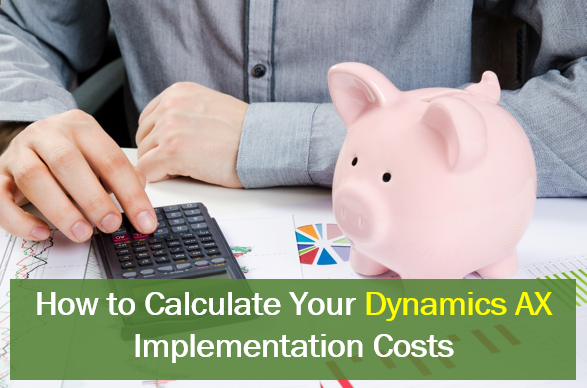July 12, 2018 - by Manoj Nair
Given the fact that Dynamics AX can completely transform the way an organization runs its business, a major challenge for most is calculating implementation costs. Many organizations end up with a failed implementation mainly due to an inaccurate estimation of implementation costs; 54% of ERP systems exceed projected budget targets.

Since there are a plethora of direct and indirect costs associated with any Dynamics AX implementation – from purchasing the software till deployment and even during post implementation support – it is imperative that you understand the various cost components – software, maintenance, infrastructure, and services costs, along with training, and support expenses to arrive at a ballpark estimate.
Cost Components of Dynamics AX Implementation
Generally, an inaccurate analysis of Dynamics AX implementation costs would add to the expenses while purchasing the software, whereas the total cost of ownership of any ERP goes far beyond that. Since a Dynamics AX implementation comprises several components, calculating the cost of each and understanding their implications on the overall costs is essential. Here’s a list of the various cost components that need to be considered:
Dependent Cost Factors
The cost of any Dynamics AX implementation depends on several factors including project scope, the size, type and location(s) of your organization, complexity of existing systems, and the implementation team size.
Company Size
One of the most important aspects of calculating Dynamics AX implementation costs is the company size and the user base. Since companies of different sizes approach ERP implementations differently, the implementation cost depends on the type of plan they’re selecting and the number of users. Also, if your business operates multiple entities (especially multiple countries), it would have an entirely different cost impact on the requirements planning, roll out approach, and training needs as opposed to if you operated from a single location.
Project Scope
Although implementing an out-of-the-box Dynamics AX software is a popular option, many organizations cherry pick modules that are relevant to their business, their industry, and their customer base. So, the overall cost of a Dynamics AX implementation depends on the modules you want to implement, customization required, and the various third-party integrations you want to include.
Complexity of Existing Systems
Any ERP implementation requires you to tweak, alter, revamp, or completely migrate some of your current processes. Therefore, implementation costs depend on the complexity of processes as well as the number of systems you are using that will eventually be replaced by the latest version of Dynamics AX. In addition, the current performance of your legacy systems and the comfort level of users will determine the degree of change management that will need to be brought in.
Implementation Team Size
The Dynamics AX implementation team size depends on the modules you want to implement and the locations you operate from. The number of SMEs involved in the implementation, as well as their level of knowledge and understanding of the company processes, also affects the team size. This is of the utmost importance for better project governance; having an optimally sized and capable team ensures a faster and more accurate implementation. This type of team will also be able to positively contribute with post go-live support as well as in training users post implementation.
Product Costs
The overall product cost of a Dynamics AX product includes several costs within it, namely:
Software Cost
The software cost includes licensing cost as well as annual maintenance cost in addition to the selected software plan cost. Both of these costs depend on the number of users and type of plan to be implemented.
Infrastructure Cost
The AX implementation cost depends upon the type of implementation you’ve opted for – either on-premises or cloud. The on-premises deployments capitalize on the customer data center / server investment, whereas the cloud deployment cost is incurred on usage basis as per the plan.
Integration Cost
Integration cost includes the cost of tools and third-party software required for integration with your Dynamics AX system. These costs vary according to the scope of implementation and the Dynamics AX software itself.
Services Cost
The services cost depends on the scope of the project, implementation at various legal entities, process maturity and complexity in addition to the support cost post implementation.
Indirect Costs
Several indirect costs are incurred during the implementation of Dynamics AX that are often ignored but have a crucial impact on the total cost of implementation. These include:
- Man-hours invested by the project team and their effort at various stages
- Change request effort costs
- Post go-live L1 support costs by client’s team
Factor All Elements
With 18% of organizations running overbudget by more than 25%, calculating the actual costs of Dynamics AX implementation is critical. Contrary to the popular assumption that the cost of implementing a Dynamics AX system only includes the software license cost, there are other costs involved: from modifying the current infrastructure, selecting the partner, purchasing the software, implementing and testing the system, training users, and investing in a post implementation support model. Although some costs are evident, many others are hidden which need special attention. Understanding all these costs generally requires a complete analysis of the Dynamics AX implementation that requires you to factor all elements that go far beyond the costs that are visible or apparent.
Learn more about planning for a successful Dynamics AX implementation.
